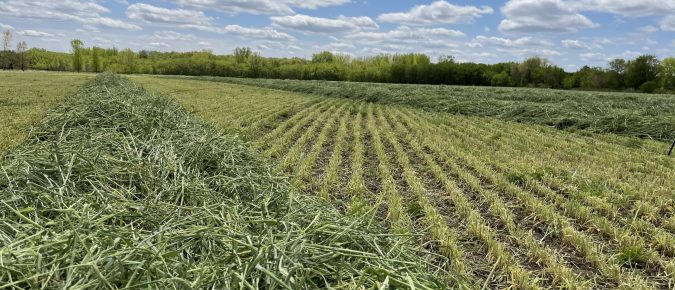Articles
Interseeding Cover Crops
Corn and soybean growers interested in using cover crops following corn and soybean crops may look to interseeding to establish a cover crop earlier in the season.
Field Notes Trailer
Spring Cover Crop Termination Considerations
Cover crop termination timing is key to maximize anticipated cover crop benefits while reducing competition with a cash crop.
Winter Wheat and Soil Carbon
September 22, 2021 12:30-1:30 pm Local Update Michael (Mike) Ballweg, Extension Crops and Soils Agent Cropping Systems and Practices that Build Soil Carbon Randy Jackson, UW-Madison Agronomy Professor Setting Up the Winter Wheat Crop for Success Shawn Conley, UW-Madison Extension Soybean & Small Grain Specialist
Aphanomyces Root Rot of Alfalfa
Aphanomyces root rot (ARR) is a serious disease of both recently seeded alfalfa and established alfalfa stands. ARR can cause severe yield reductions in affected alfalfa fields. Variations of the disease also occur on many other legumes (including soybean, snap bean, faba bean, red kidney bean, pea, red clover, and white clover) and can cause significant losses in these crops as well.
Considerations for Selecting Annual Grain Hybrids and Varieties
The selection of corn hybrids and soybean and small grain varieties has a major influence on yield and overall profitability of crop production. The disparity in yield between varieties on both ends of the spectrum is quite large. At the University of Wisconsin, corn hybrid research has shown an average yield spread of 70 bushels/acre […]
Find a farm enterprise that’s right for you with eFarmony, the agricultural matching tool
Trying to decide what agriculture enterprise is right for you? An online tool from UW-Madison Extension helps you determine which is the best fit for you.
Harvest Season Clean Out
Limiting the spread of weed seed between fields is a key part of an integrated pest management system. This is especially important, because the weeds present at harvest were allowed to produce seed and have survived other control attempts during the growing season. These weed seeds, if allowed to spread and germinate, have the potential to become difficult to control elsewhere.
Effect of Seedling Year Stress on Future Alfalfa Yields
Stress in the seeding year reduces future yields of alfalfa. This occurs because the seeding year determines the stand plant density as well as individual plant size and vigor. The following paragraphs will show that autotoxicity, potato leaf hopper, cover crop, and, possibly, drought stresses in the seeding year will reduce alfalfa yield in future years, even when the stress is gone.
Weighing the Risk of Fall Alfalfa Harvest – Balancing Forage Production and Potential Stand Longevity
The decision to take a late summer or fall cutting of alfalfa should be considered carefully. A farm should evaluate current forage needs, economics, stand health, and timing to make the best decision for their individual situation. Although the need for more forage may override some other factors, the timing of harvest is still critical. […]














